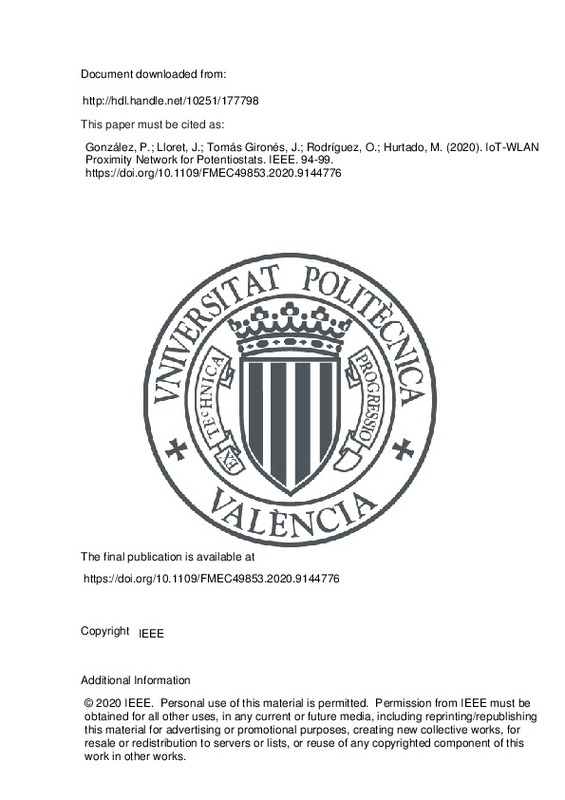JavaScript is disabled for your browser. Some features of this site may not work without it.
Buscar en RiuNet
Listar
Mi cuenta
Estadísticas
Ayuda RiuNet
Admin. UPV
IoT-WLAN Proximity Network for Potentiostats
Mostrar el registro sencillo del ítem
Ficheros en el ítem
| dc.contributor.author | González, Pedro
|
es_ES |
| dc.contributor.author | Lloret, Jaime
|
es_ES |
| dc.contributor.author | Tomás Gironés, Jesús
|
es_ES |
| dc.contributor.author | Rodríguez, Oscar
|
es_ES |
| dc.contributor.author | Hurtado, Mikel
|
es_ES |
| dc.date.accessioned | 2021-12-01T09:44:38Z | |
| dc.date.available | 2021-12-01T09:44:38Z | |
| dc.date.issued | 2020-07-03 | es_ES |
| dc.identifier.isbn | 978-1-7281-7216-3 | es_ES |
| dc.identifier.uri | http://hdl.handle.net/10251/177798 | |
| dc.description | © 2020 IEEE. Personal use of this material is permitted. Permission from IEEE must be obtained for all other uses, in any current or future media, including reprinting/republishing this material for advertising or promotional purposes, creating new collective works, for resale or redistribution to servers or lists, or reuse of any copyrighted component of this work in other works. | es_ES |
| dc.description.abstract | [EN] The implementation of potentiostats as portable and communicated devices has reached significant progress to benefit research, industry, and education. The Internet of Things (IoT) is a good opportunity to interconnect devices such as the potentiostats together with electronics, communication technologies, and chemistry into a single system. This work proposes a network for potentiostats using machine-to-machine (M2M) protocols, modifying its functioning mechanism in the broker to check the payload of the message that passes through it and synchronize the sensors depending on its content. Although one sensor can be synchronized directly to another, the broker decides which sensor to pair. This modification was made in the M2M protocol algorithm, both in the Broker and in the Client (sensor). In addition to this, the network uses an interconnection architecture of IoT smart networks of proximity with centralized management. The results of the tests carried out showed that the use of a modified M2M such as the one proposed in the architecture allows synchronization and comparison of the measurements of several sensors in real-time. | es_ES |
| dc.language | Inglés | es_ES |
| dc.publisher | IEEE | es_ES |
| dc.relation.ispartof | 2020 Fifth International Conference on Fog and Mobile Edge Computing (FMEC) | es_ES |
| dc.rights | Reserva de todos los derechos | es_ES |
| dc.subject | Internet of things | es_ES |
| dc.subject | Artificial intelligence | es_ES |
| dc.subject | Potentiostats | es_ES |
| dc.subject | M2M Protocol | es_ES |
| dc.subject | Mobile app | es_ES |
| dc.subject | IoT-WLAN | es_ES |
| dc.subject | MQTT | es_ES |
| dc.subject.classification | INGENIERIA TELEMATICA | es_ES |
| dc.title | IoT-WLAN Proximity Network for Potentiostats | es_ES |
| dc.type | Comunicación en congreso | es_ES |
| dc.type | Capítulo de libro | es_ES |
| dc.identifier.doi | 10.1109/FMEC49853.2020.9144776 | es_ES |
| dc.rights.accessRights | Abierto | es_ES |
| dc.contributor.affiliation | Universitat Politècnica de València. Departamento de Comunicaciones - Departament de Comunicacions | es_ES |
| dc.description.bibliographicCitation | González, P.; Lloret, J.; Tomás Gironés, J.; Rodríguez, O.; Hurtado, M. (2020). IoT-WLAN Proximity Network for Potentiostats. IEEE. 94-99. https://doi.org/10.1109/FMEC49853.2020.9144776 | es_ES |
| dc.description.accrualMethod | S | es_ES |
| dc.relation.conferencename | Fifth International Conference on Fog and Mobile Edge Computing (FMEC 2020) | es_ES |
| dc.relation.conferencedate | Junio 30-Julio 03,2020 | es_ES |
| dc.relation.conferenceplace | Online | es_ES |
| dc.relation.publisherversion | https://doi.org/10.1109/FMEC49853.2020.9144776 | es_ES |
| dc.description.upvformatpinicio | 94 | es_ES |
| dc.description.upvformatpfin | 99 | es_ES |
| dc.type.version | info:eu-repo/semantics/publishedVersion | es_ES |
| dc.relation.pasarela | S\419403 | es_ES |







![[Cerrado]](/themes/UPV/images/candado.png)

